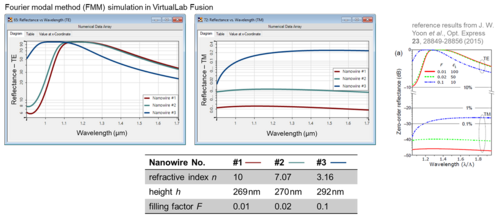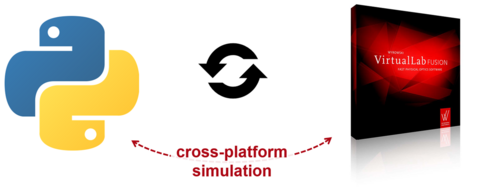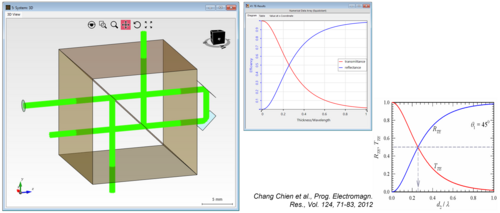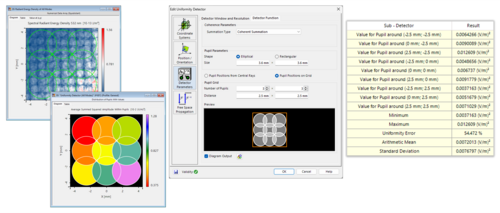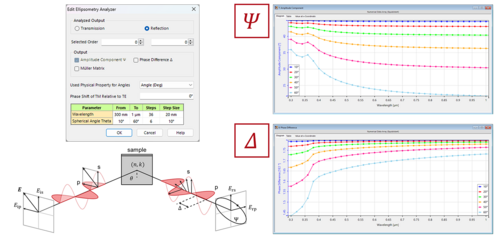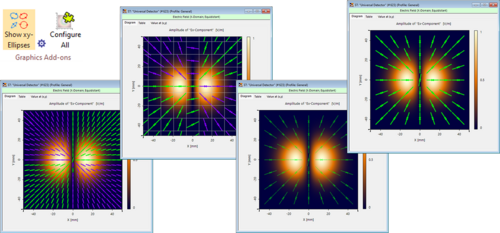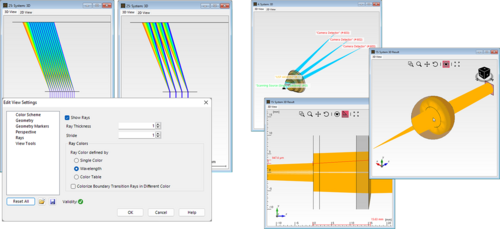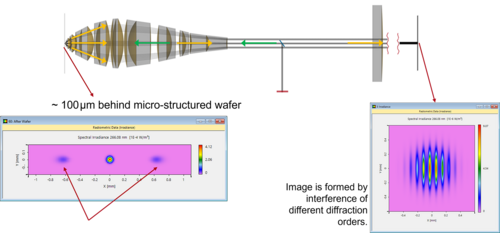What’s new in our Optical Modeling and Design Software?
In-Depth Analysis of Polarizer Gratings with Sub-Wavelength Structures
Ultra-sparse nanowire grids – grating structures consisting of periodic dielectric wires with a cross section much smaller than the used wavelength – exhibit strong polarization dependencies over a wide range of wavelengths. These characteristics make them a viable choice as nanostructured polarizers for optical systems, where compact integrability and thermal stability are critical, and this approach has distinct advantages over its conventionally used counterparts based on birefringent crystals or multilayer systems.
In this week’s newsletter we perform a detailed analysis of such a structure in the fast physical optics modeling and design software VirtualLab Fusion, using the work of [J. W. Yoon et al., Opt. Express 23, 28849-28856 (2015)] as a reference. In this example, we not only calculate the polarization-dependent efficiencies of the light reflected and transmitted by the periodic structure, but also visualize how the field propagates inside, clearly illustrating the polarizing behavior of the nanowire arrangement: The TM-polarized part travels through practically unaffected, while the TE-polarized component is almost completely reflected.
This analysis is enabled by VirtualLab Fusion’s Field Inside Component Analyzer: FMM. You can also find a detailed guide to this at the links below.
Cross-Platform Simulations with Python
The fast physical optics software VirtualLab Fusion prides itself on its “connecting field solvers” approach, which brings together different specialized electromagnetic field solvers applied on different components in a seamless, non-sequential way, to enable the physical optics simulation of the whole system. The logical extension of this approach is to not only connect solutions inside the software, but to also allow cross-platform simulations to reap the benefits from other programs or programming languages in combination with the physical-optics know-how that characterizes VirtualLab Fusion, thus extending the options for simulation, optimization, design and post-processing.
Hence, in this week’s newsletter we are doing a deep dive in how to use the programming language Python to call and control simulations in VirtualLab Fusion. Please take a look at the documents linked below to find a detailed guide on how to set up and work with the interface between Python and VirtualLab Fusion, accompanied by an application example in which we perform a parameter sweep on a grating in 1D and 2D.
Real Beam Splitter for Interferometer Applications
Interferometry is a keystone technology for many applications in the area of optical metrology. It is widely used for the measurements of e.g. surface profiles, defects and mechanical or thermal distortion with high precision. Most interferometry systems rely strongly on beam splitters that divide the incoming beam. A detailed investigation of all the different physical effects these components may have on the light requires a modeling approach that can simulate real optical beam splitter components.
With this in mind, we share two use cases in this week’s newsletter that incorporate the most common designs for such kind of beam splitters. In the first one we have a look at a cube beam splitter based on Frustrated Total Internal Reflection (FTIR) and demonstrate how the gap influences the transmission and reflection efficiencies. In the second use case we investigate the phase shift created by a real beam splitter in comparison to an idealized, functional one.
New Features for Lightguide Modeling
With the release of version 2023.1 a whole pack of new and interesting features have been added to the fast physical optics modeling and design software VirtualLab Fusion. Fitting to one of the themes of the release – the “Detector Revolution” – we presented new tools to extract information about your optical system by means of the new Universal Detector and various helpful Add-ons.
In this week’s newsletter we want to highlight especially the new additions that have been made to the Lightguide Toolbox – our go-to tool for anyone interested in applications in the field of augmented and mixed reality (AR & MR), like the design and analysis of Near-Eye Displays. With the new release users have access to an overhauled Uniformity Detector that now includes graphical representations of the pupils that are used to calculate the uniformity, for a more convenient use. Furthermore, we also added a brand-new detector add-on designed to share information from the lightguide with the detector. With its help, users can now detect the field inside a lightguide and see the grating regions superimposed on the result. For more information, please take a look at the documents below.
Read moreOptical Thin-Film Measurements by Ellipsometry
Ellipsometry is an optical measuring method that utilizes the polarization changes that happen whenever light is reflected by (or transmitted through) a surface, e.g. of a bulk material or thin-film. Over time it has gained popularity in semiconductor and optical coating applications due to its higher sensitivity in comparison to traditional reflection measurements. Therefore, ellipsometry is now used to accurately characterize composition, roughness, thickness, crystalline properties, electrical conductivity, and other material properties of diverse samples.
In the latest release of the fast physical optics software VirtualLab Fusion, 2023.1, the Ellipsometry Analyzer has been added to the ever-increasing array of features available in the software. It provides an easy and straightforward way to investigate the properties of coatings, multi-layer structures and gratings through the application of ellipsometry concepts on the electromagnetic field results produced by the simulation. In addition, it offers the possibility of varying the wavelength and the incidence angle automatically from within the analyzer itself, in order to conveniently generate the typical ellipsometry curves which can, after being fitted to a model, go on to reveal the material properties we seek to obtain from these experiments. You can find below links to the documentation that explains how to work with this new analyzer, as well as an example scenario in which the tool in question is applied to a silicon dioxide coating.
Graphical Representation of Polarization Ellipses
As light is much more than just power and flux, the full vectorial representation as an electromagnetic field is of interest for most modern optical applications where the polarization state of the light can be influenced by anything from gratings to refractive surfaces. In order to be able to account, not just for the polarization properties of the source, but also for the (potentially complex) evolution of the polarization state as the light propagates through the system, the latest release of the fast physical optics modeling and design software VirtualLab Fusion, 2023.1, offers the possibility of displaying the polarization state of the electromagnetic field as a graphical overlay directly on top of the field data. The so-called polarization ellipses are a common way to visualize the time-dependent path followed by the field vector in space. However, in non-paraxial systems, these ellipses exhibit in general a three-dimensional, locally varying behavior that is a far cry from the simplified global polarization in two dimensions that is typically covered in optics education. The gridded overlay provided in VirtualLab Fusion can easily describe any local variation of the polarization, and with the option to configure which cross section the displayed polarization ellipses refer to, the full three-dimensional path of the electric field vector can also be visualized.
A detailed document about this feature, detailing its function and visualization options, can be found below. The technology behind this – Graphics Add-ons – is also used to easily superimpose other information onto the field. Examples of this could be a point cloud representing the dot diagram that corresponds to a given field result, or a region in which a detector is active, both of which can be overlayed onto the field data with a few clicks. An overview of the different uses of Graphic Add-ons can also be found in the documents below.
Read more3D System Visualization
To obtain a fundamental understanding of the geometry of an optical system as well as of the positions of the individual elements relative to each other, the fast physical optics modeling and design software VirtualLab Fusion offers specific tools that produce results comparable to those of classic ray tracers. In the latest version, 2023.1, these tools have been overhauled to make them easier to use. We also included new functionalities, such as the ability to make a magnifying glass appear around the cursor, or full-sized rulers around the edges of the document that automatically track the x and y position of the mouse cursor. In the examples below, you can find an in-depth description of the tool itself and an application example of an f-theta lens.
Read moreInterference-Based Optical Testing Systems
To perform high-precision inspections of structured surfaces, which are commonly used in e.g. the semiconductor industry, optical testing systems based on interference effects can be used. A full simulation of these setups needs to include all physical optical effects, like diffraction at the structure, coherence and the resulting interference at the image plane. To help the optical engineer in this task, the fast physical optics software VirtualLab Fusion offers a series of tools to include diffraction and non-sequential modelling in the system.
With the release of the new version 2023.1 we also provide a new detector concept which allows the user to calculate any physical quantity that might be of interest, directly from the field information. To see all these tools in action, we showcase two examples below. In the first one, a high-NA objective is used to inspect an asymmetric micro-structured wafer, while in the second example we show the irradiance patterns from a classical Fizeau interferometer using differently shaped test surfaces.
Read more



